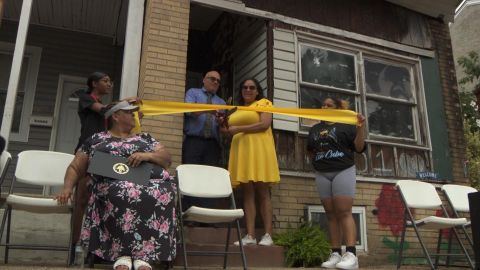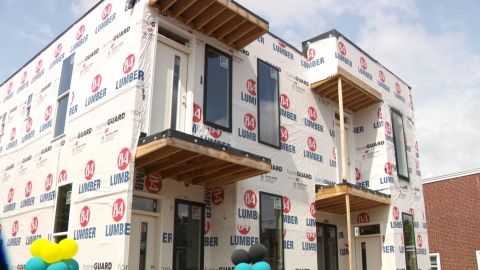NJ’s affordable housing crisis: Who decides what gets built?
Now that the State Supreme Court has ruled New Jersey municipalities do have an obligation to provide affordable housing, townships face two choices. One is to settle, the other to sue. Several hundred have chosen the latter. That’s drawn conflicting solutions from stakeholders on all sides of the political spectrum. From our partners at NJTV News, correspondent Briana Vannozzi reports on fulfilling the requirement for those still chasing the dream.
If you ask a half dozen different stakeholders how New Jersey should implement affordable housing, you’re probably going to get a half dozen different answers. Fortunately, there is one area where everyone seems to be on the same page.
“Every single person I’ve spoken with agrees that there is a housing affordability issue in this state,” said Assemblywoman Holly Schepisi. “And we need to work together to come up with creative ways to address that.”
The Bergen County assemblywoman’s district is home to dozens of municipalities fighting the Mount Laurel Supreme Court ruling. Schepisi has taken the lead in the Legislature, drafting a plan to satisfy affordable housing requirements while also providing towns with options that work for them, rather than ones handed down by trial judges.
“One of my first bills was, let’s sit down take a breather, let’s work together across the aisle and come up with a better solution and let’s do our job the way the Supreme Court told us to do. And immediately, I was attacked as racist and xenophobic,” said Schepisi.
That’s partly because the divide over affordable housing regulations has deeply rooted racial tensions, drawn from decades-long narratives about violence and crime following low income, mainly minority, residents. It’s the “not in my backyard” attitude. The delicate nature of it all has caused many lawmakers to stay out of the debate entirely.
“We need to increase the cap to allow more senior housing to be viewed as eligible as well as special needs. We need to start looking at innovative things of public private partnerships we have 40,000 homes sitting vacant,” said Schepisi.
Schepisi is proposing a statewide solution, one that would put more affordable housing in towns where the infrastructure to accommodate more residents is already in place. But that’s exactly the kind of thinking that Fair Share Housing Center opposes. Peter O’Connor founded the organization and is one of the attorneys from the original Mount Laurel case. He says that would keep low income residents in already densely populated, urban areas.
“I’ve been working on this for almost 47 years,” said O’Connor. “I’ve been involved since the beginning and the major objective was to give people in communities like Camden a choice whether to stay or live in a more economic and racially balanced community, the Supreme Court has backed that goal and the municipalities have slowed that growth.”
He believes the courts need to be involved as a neutral arbitrator.
“This is such a political issue. The towns would opt for the lowest possible formula and figures and we as advocates would follow the COAH standards at a higher number,” O’Connor said.
It’s been easy for all parties to point fingers at the Council on Affordable Housing, or COAH. After all, the agency did fail to come up with rules and obligations for towns to follow. Former Department of Community Affairs Commissioner Lori Grifa was responsible for the agency for two years under Gov. Chris Christie.
“Since December 2009, the state of New Jersey has lost every single battle; the housing advocates have won every battle,” she said. “That would tell you that that state’s not doing it right.”
Grifa said there has been criticism of COAH from all sides.
“Regardless of whether you were Democrat or Republican, from a big or little town, north or south, suburban or rural, there were people of every one of those communities who had something negative to say about the program so that was really the challenge,” she said.
According to Grifa, COAH couldn’t come up with an alternate plan to Mount Laurel that could survive court challenges. That was made worse by legislative inaction. But even though COAH failed, Grifa said the state’s involvement keeps towns from skirting their obligations.
“There have been towns sitting on the sidelines with their hands in their pockets who are basically deciding they weren’t going to do anything until the courts spoke and the failure to do anything over a 15-year period actually has created a number that is pretty big. But that was a choice,” she continued.
Jeffrey Surenian represents 60 municipalities that are fighting the Supreme Court ruling.
“Nobody credibly questions the need,” said Surenian. “The question becomes, how should it be calculated in view of the practical realities and the limitations the Legislature established in the Fair Housing Act?”
He said the towns are facing a costly burden according to Fair Share Housing’s estimates, which claim the state needs to build at least another 200,000 units. And small municipalities aren’t equipped to handle the services that come with it. So far, roughly 140 out of the 350 towns bringing litigation have settled on their numbers.
“There’s a big myth and that myth is that the bigger the numbers, the more affordable housing you’ll have. That’s not true,” said Surenian. “What will drive the production of affordable housing in the state is the market for market-housing so that the market housing can generate revenue to subsidize affordable units in traditional inclusionary development where 20 percent of the units are affordable.”
Grifa said when it comes to municipalities, where there’s a will, there’s a way.
“Fact of the matter is, if towns are committed to providing affordable housing those towns tend to find a way to get it done,” she said.



